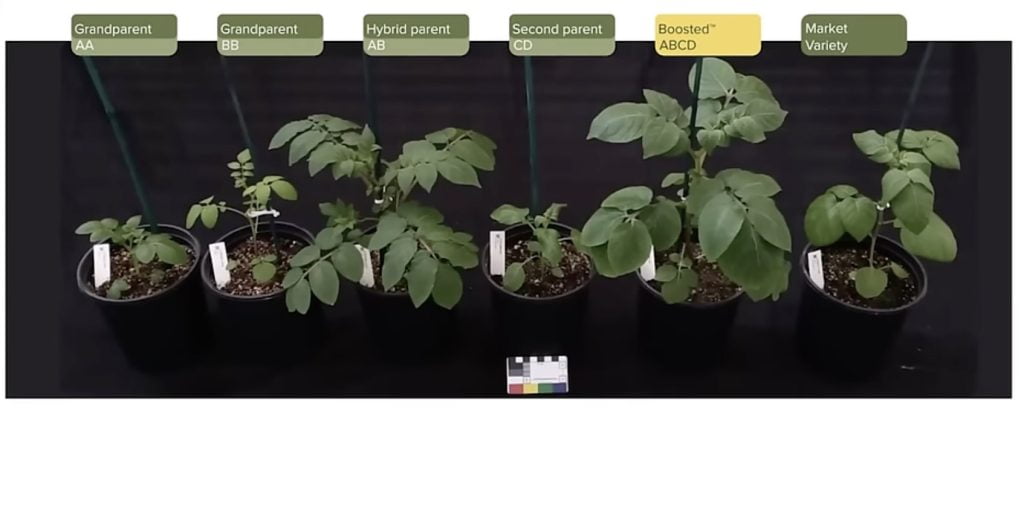פורצת דרך בטכנולוגיה חקלאית, אוהלו חשפה לאחרונה את הטכנולוגיה המהפכנית שלה "Boosted Breeding" בפודקאסט All-In. הוצג על ידי דוד פרידברג, שיטה פורצת דרך זו שואפת להגדיל באופן מסיבי את תפוקת היבול על ידי שינוי המבנה הגנטי של הצמחים. על ידי מתן אפשרות לצמחים להעביר 100% מהגנים שלהם לצאצאיהם, ולא רק מחציתם, הטכנולוגיה של Ohalo עומדת לשנות את התעשייה החקלאית. בואו נצלול לתוך המשמעות של זה עבור עתיד החקלאות, ייצור המזון והקיימות העולמית.
"עד שהפוד הזה ישודר, אנחנו הולכים להכריז על מה אהלו מתפתחת בחמש השנים האחרונות ועברה פריצת דרך מדהימה בתחום, שהיא בעצם טכנולוגיה חדשה בחקלאות. אנחנו קוראים לזה רבייה מוגברת".
דיוויד פרידברג בפודקאסט All-In

זכויות יוצרים: הכל בפודקאסט
במאמר זה נחקור:
- המדע הייחודי מאחורי הגידול המוגבר של אוהלו
- כיצד טכנולוגיה זו יכולה להשפיע על התפוקה והפרודוקטיביות
- ההשלכות המעשיות על חקלאים וצרכנים
- תיאור מקרה מפורט על האופן שבו הטכנולוגיה של אוהלו יכולה לשנות את יבול תפוחי האדמה
- ההשלכות העולמיות לביטחון תזונתי וקיימות
- היתרונות הכלכליים למגזר החקלאי
מהי טכנולוגיית הגידול המוגברת של אוהלו?
גידול מוגבר, כפי שהוצג על ידי דיוויד פרידברג, הוא א חָדָשׁ טכנולוגיה חקלאית שפותחה על ידי Ohalo בחמש השנים האחרונות. הנחת היסוד המרכזית מאחורי טכנולוגיה זו היא שהיא מאפשרת לצמחים להעביר 100% מהגנים שלהם לצאצאיהם, ולא את ה-50% המסורתי. על ידי יישום חלבונים ספציפיים לצמחי האם, הטכנולוגיה של אוהלו מכבה את מעגלי הרבייה הטבעיים שגורמים לצמחים לפצל את הגנים שלהם. כתוצאה מכך, הצאצאים מקבלים את כל ה-DNA משני צמחי האב, וכתוצאה מכך צמחים בעלי חומר גנטי כפול.
רבייה מוגברת יכולה להוביל ליבול גבוה יותר, עלות נמוכה יותר וקיימות משופרת בחקלאות.
פרידברג מסביר, "היתה לנו תיאוריה שנוכל לשנות את האופן שבו צמחים מתרבים. אם היינו יכולים לעשות את זה, אז כל הגנים מהאם וכל הגנים מהאב היו משתלבים בצאצאים". זה משנה מהותית את הנוף הגנטי, ומאפשר שיפורים משמעותיים בתפוקת היבול ובריאות הצמח.
טכנולוגיית רבייה מוגברת מאפשרת לצמחים להעביר 100% מהגנים שלהם לצאצאיהם.
מה שהופך את הרבייה המוגברת לכל כך טרנספורמטיבית הוא הפוטנציאל שלה לשלב את כל הגנים המועילים מצמחי אב שונים לצאצא בודד. בגידול צמחים מסורתי, זה יכול לקחת עשרות שנים כדי להשיג צמח שיש לו את כל הגנטיקה הרצויה עבור תכונות כמו עמידות למחלות וסבילות לבצורת. עם רבייה מוגברת, תהליך זה מואץ באופן אקספוננציאלי. במקום שילוב אקראי של גנים, הצאצאים יורשים את כל התכונות המועילות משני ההורים.
המדע שמאחורי גידול רבייה
בלב טכנולוגיית "הגידול המוגבר" פורצת הדרך של אוהלו היא גישה חדשנית לרביית צמחים. שיטות הרבייה המסורתיות מסתמכות על השילוב הבלתי צפוי של גנים משני צמחי הורה, כאשר כל הורה תורם מחצית מהחומר הגנטי שלו לצאצאים. עם זאת, פריצת הדרך המרגשת של אוהלו משנה את המשחק לחלוטין.

זכויות יוצרים: הכל בפודקאסט
דיוויד פרידברג, מסביר כי רבייה מוגברת מאפשרת לצאצא לרשת 100% מהגנים משני צמחי האב. על ידי שימוש בחלבונים ספציפיים כדי לתמרן את תהליך הרבייה, אוהלו הצליח למנוע את החצייה הרגילה של החומר הגנטי. כתוצאה מכך נוצרים צאצאים בעלי DNA כפול, המשלבים את כל התכונות המועילות של שני ההורים.
פוליפואידיה מתרחשת באופן טבעי בחלק מהצמחים כמו חיטה, תפוחי אדמה ותותים.
"הערכנו תיאוריה שעל ידי שינוי האופן שבו צמחים מתרבים, נוכל לאפשר להם להעביר 100% מהגנים שלהם לצאצאים שלהם במקום רק חצי", מפרט פרידברג. "משמעות הדבר היא שכל הגנים הן מהאם והן מהאב משתלבים בצאצאים, מה שמוביל לשיפור משמעותי בתפוקת היבול ובבריאות הצמח". בעיקרו של דבר, טכנולוגיה זו מבטיחה שהצאצאים מבטאים באופן מלא את מגוון התכונות הרצויות הקיימות בשני ההורים.
טכנולוגיה זו, הידועה מדעית כפוליפלואידיה, אינה חדשה לגמרי בטבעה. פוליפואידיה מתרחשת כאשר אורגניזמים, צמחים בפרט, מכפילים באופן טבעי את קבוצות הכרומוזומים שלהם. לדוגמה, בני אדם הם דיפלואידים עם שתי קבוצות של כרומוזומים; חיטה היא הקספלואידית עם שישה סטים. על ידי גרימת פוליפלואידית באופן מלאכותי, Ohalo יכול לשפר משמעותית את תכונות הצמח, ולהציע פתרון בר קיימא ליצירת יבולים עמידים ופרודוקטיביים יותר.
אחד הדגמים הראשונים ששימשו לבדיקת טכנולוגיה זו היה עשב קטן המכונה ארבידופסיס. "ראינו עלייה בתשואה של 50 ל-100% או יותר", מציין פרידברג. הצלחה ראשונית זו הניחה את הקרקע לבדיקות הבאות על גידולי יסוד כמו תפוחי אדמה, שבהם התוצאות היו לא פחות מיוצאות דופן. הצאצאים המוחזקים של גידולים אלה הוכיחו עליות יוצאות דופן בגודל, יבול ועמידות למחלות - כולם גורמים חיוניים לפריון החקלאי.

זכויות יוצרים: הכל בפודקאסט
ההסבר של פרידברג על התרמיל מדגיש את הריקוד המורכב של הגנים שמתרחש בגידול מסורתי וכיצד הגישה של אוהלו מחוללת מהפכה בתהליך זה. על ידי עקיפה מהמבחר האקראי של גנים, רבייה מוגברת מסירה את אי הוודאות שהטרידה זמן רב את מגדלי הצמחים. במקום להשקיע עשרות שנים בניסיון ליצור את היבול המושלם באמצעות אינספור הצלבות גנטיות, השיטה של אוהלו מאפשרת שילוב מיידי של כל התכונות הרצויות, מה שמאיץ באופן דרמטי את מחזור הרבייה.
יתרה מכך, כל קבוצה של גנים, בדומה לכלים בארגז כלים, מציידת את הצמח במנגנונים טובים יותר להתמודד עם מתחים שונים כמו בצורת או מחלות. "ככל שיש לצמח יותר גנים שמועילים, כך גדל הסיכוי שהוא ימשיך לגדול בתנאים שליליים", מציין פרידברג. זה גורם לא רק לצמחים גדולים יותר אלא גם לצמחים עמידים יותר, המסוגלים לשגשג בסביבות פחות אידיאליות.
באמצעות שיטה מהפכנית זו, צמחי זרעים אחידים וצפויים יותר, וסוללים את הדרך לפרקטיקה חקלאית יעילה ובת קיימא יותר. עקביות זו חיונית לא רק למיקסום התשואה אלא גם לפישוט תהליך החקלאות ולפיתוח תעשיות זרעים חזקות.
הגידול המוגבר של אוהלו הוא לא רק צעד קדימה - זה קפיצה שיש לה פוטנציאל לשנות את החקלאות כפי שאנו מכירים אותה, מה שמאפשר לייצר יותר מזון עם פחות משאבים, להבטיח ביטחון תזונתי ולמתן את ההשפעות של שינויי האקלים.
השפעה על תפוקת יבול ותפוקה
הרעיון של רבייה מוגברת על ידי Ohalo עומד לחולל מהפכה בתפוקת היבול ובפרודוקטיביות. דיוויד פרידברג שיתף בפודקאסט All-In שעם גישה חדשנית זו, יבולים יכולים להשיג עליות יבול של 50% עד 100% או יותר. שיטות גידול מסורתיות, לשם השוואה, מניבות בדרך כלל עלייה של 1.5% בשנה ויכולות להימשך עשרות שנים כדי להשיג שיפורים משמעותיים.
דמיינו לעצמכם צמח המשלב בדרך כלל רק מחצית מהגנטיקה של כל הורה. על ידי הבטחה שהצאצאים יורשו 100% של הגנים משני ההורים, הטכנולוגיה של אוהלו מאפשרת לכל הספקטרום של התכונות הרצויות להתבטא בצמח החדש. זה מביא בסופו של דבר לצמחים בריאים וחזקים יותר, המצוידים טוב יותר להתמודד עם גורמי לחץ סביבתיים. פרידברג הסביר, "התשואה על חלק מהצמחים הללו עולה ב-50 ל-100% או יותר."

זכויות יוצרים: הכל בפודקאסט
לשם המחשה, פרידברג הציג נתונים הכוללים עשב קטן וניסיוני בשם ארבידופסיס. הצאצאים, שפותחו באמצעות המערכת של אוהלו, הפגינו גידול משמעותי בגודל ובבריאות בהשוואה לצמחי האם שלו. "מה שיש לנו בראש הם שני ההורים האלה A ו-B, ואז יישמנו עליהם את הטכנולוגיה המוגברת שלנו", אמר. "אתה יכול לראות שהצמח מימין הרבה יותר גדול, יש לו עלים גדולים יותר, הוא נראה בריא יותר וכו'."
התוצאות היו בולטות עוד יותר עם גידולים מסחריים, כגון תפוחי אדמה. "תפוח אדמה הוא המקור השלישי בגודלו לקלוריות על פני כדור הארץ", אמר פרידברג. באחד הניסויים שלהם, תפוח האדמה ה"בוסט" שנוצר, ששילב את הגנטיקה של שני זנים שונים, הניב משקל כולל של 682 גרם מצמח בודד. בניגוד גמור, צמחי האם הפיקו רק 33 גרם ו-29 גרם, בהתאמה. לגידול העצום הזה בפריון עשויות להיות השלכות מונומנטליות על אספקת המזון העולמית ועל ביטחון המזון.
הקפיצה הזו בפריון לא נעצרת רק בתפוחי אדמה. טכנולוגיית הגידול המוגברת של Ohalo פותחת את הדלת לשיפורי יבול משמעותיים בגידולים מרכזיים רבים. כפי שציין פרידברג, הפוטנציאל מרחיקי הלכת של הטכנולוגיה הזו הוא עצום. "אנחנו עובדים על לעשות את זה עם כל קו תפוחי אדמה גדול וגידולים רבים אחרים ברחבי הלוח", אמר. יישום נרחב זה יכול להוביל לעידן חדש של שופע ו חקלאות בת קיימא.
מה זה אומר עבור חקלאים וצרכנים
עבור החקלאים, הופעתה של טכנולוגיית הגידול המוגברת של אוהלו מסמנת שינוי מהפכני בשיטות החקלאות. פרידברג מדגישה את הפוטנציאל של טכנולוגיה זו להגדיל תשואות יבול עד 50 עד 100%, ניגוד מוחלט לשיטות הגידול המסורתיות ששלטו זה מכבר בתעשייה עם עליות יבול שנתי זעום של בסביבות 1.5%. עלייה דרמטית זו בפריון פירושה שחקלאים יכולים לטפח יותר מזון על פחות אדמה, יתרון מכריע ככל שהאוכלוסיות העולמיות ממשיכות להמריא.
חשוב לציין, היכולת לשלוט ולשפר תכונות צמחיות ספציפיות - כגון עמידות לבצורת או עמידות למחלות - באמצעות שילובי גנים ממוקדים מציעה לחקלאים רמה חדשה של דיוק בייצור היבול שלהם. זה לא רק מוביל ליבולים גבוהים יותר אלא גם מאפשר לגידולים לשגשג בתנאים פחות אידיאליים, ומפחית את הסיכון לכשל ביבול עקב מזג אוויר שלילי או התפרצויות מחלות. כפי שהדגיש פרידברג, יבולים כמו תפוחי אדמה יכולים לראות קפיצה מדהימה ביבול כאשר מיישמים טכניקות גידול מוגברות, כאשר זנים מסוימים מייצרים עד 682 גרם לעומת 33 גרם טיפוסיים. שיפור החוסן והיעילות יקטין את עלויות התשומות לחקלאים, במיוחד במונחים של מים ודשן, תוך הפחתת ההשפעה הסביבתית.

זכויות יוצרים: הכל בפודקאסט
הצרכנים עשויים להפיק תועלת שווה מההתקדמות הללו. עם עלייה בתשואות היבול ובריאות הצמחים משופרת, ניתן לטפל בבעיות מחסור במזון בצורה יעילה יותר. זה חיוני במיוחד באזורים שבהם תת תזונה עדיין מהווה דאגה משמעותית. בכך שהיא מאפשרת לגדל יותר מזון באופן מקומי באקלים ובסוגי קרקע מגוונים, הטכנולוגיה של Ohalo יכולה לעזור לגשר על הפער בהפצת המזון העולמית, בסופו של דבר לתרום להורדת מחירי המזון ולשיפור הביטחון התזונתי. יתרה מכך, היכולת לייצר זרעים מושלמים פירושה איכות יבול עקבית יותר, מה שמבטיח שהצרכנים מקבלים תוצרת איכותית בכל פעם שהם קונים.
השלכה מכרעת נוספת עבור הצרכנים היא הפוטנציאל לשיפור הערך התזונתי והטעם. עם היכולת לשלב את התכונות הגנטיות הטובות ביותר, רבייה מוגברת יכולה לייצר יבולים שהם לא רק שופעים יותר אלא גם עשירים יותר בחומרי הזנה חיוניים. זה יכול להוביל לעתיד שבו פירות וירקות הם לא רק סבירים יותר אלא גם בריאים וטעימים יותר - מנצח עבור חקלאים וצרכנים כאחד.
טכנולוגיית הגידול המוגברת של Ohalo מבטיחה עידן חדש של פרודוקטיביות חקלאית וקיימות, עם יתרונות מרחיקי לכת הן לחקלאים והן לצרכנים. על ידי מינוף טכניקות גנטיות חדשניות, אנו יכולים לצפות למערכת מזון עמידה יותר המסוגלת לעמוד בדרישות ההולכות וגדלות של אוכלוסייה גלובלית הולכת וגדלה.
מקרה מבחן: שינוי תפוקות תפוחי אדמה
טכנולוגיית הגידול המוגברת של Ohalo הראתה תוצאות יוצאות דופן עם גידולי תפוחי אדמה, ומיצבה אותה כמשנה משחק לפריון החקלאי. לפי דיוויד פרידברג, תפוחי אדמה הם המקור השלישי בגודלו לקלוריות בעולם; לכן, לשיפור התפוקה שלהם יכולה להיות השפעה עמוקה על ביטחון המזון. הניסויים שביצעה אוהלו הדגימו עלייה משמעותית בתפוקת תפוחי האדמה על ידי שימוש בטכניקת הגידול המוגברת.

זכויות יוצרים: הכל בפודקאסט
באחד מהניסויים הבולטים שלהם, הצוות השתמש בשני צמחי תפוחי אדמה הורים שסומנו כ-A ו-CD. לשניהם היו יבול צנוע יחסית כאשר גדלו בנפרד, והניבו 33 גרם ו-29 גרם תפוחי אדמה בהתאמה. עם זאת, על ידי יישום טכנולוגיית הגידול המוגברת של Ohalo, הם יצרו צמח תפוחי אדמה, המכונה ABCD, שהציג יבול מדהים של 682 גרם. תוצאה זו מתורגמת ליותר מפי 20 בתשואה בהשוואה להוריו. תפוחי האדמה המוגברים הללו היו לא רק גדולים יותר אלא גם בריאים יותר, והיוו טענה משכנעת ליכולתה של הטכנולוגיה לשפר באופן קיצוני את פרודוקטיביות היבול.
"העלייה בתשואה הייתה מטורפת", אמר פרידברג במהלך הפודקאסט, והדגיש את האופי חסר התקדים של התוצאות.
מבחינה מעשית, עלייה זו ביבול טומנת בחובה פוטנציאל משמעותי לאזורים הנשענים במידה רבה על חקלאות תפוחי אדמה, כמו חלקים מאפריקה והודו. פרידברג ציין כי חקלאים הודים, שלעתים קרובות מגדלים תפוחי אדמה על שטחים גדולים וצורכים
השלכות גלובליות: להאכיל את העולם
ככל שהאוכלוסייה העולמית ממשיכה לטפס, הצורך להגביר את ייצור המזון הופך יותר ויותר קריטי. עד שנת 2050, העולם יצטרך לייצר 69% יותר מזון מאשר ב-2006, אתגר מרתיע בהתחשב במגבלות הנוכחיות של הפריון החקלאי והדאגות הסביבתיות המתרחבות. עבודתו פורצת הדרך של דיוויד פרידברג עם טכנולוגיית הגידול המוגברת של Ohalo יכולה לספק את החדשנות הדרושה כדי לגשר על הפער הזה, ולהציע דרך להגדלת יבול היבול ללא העלות הסביבתית הנלווית.
במהלך המצגת שלו בפודקאסט All-In, פרידברג הבהיר כיצד טכנולוגיה זו יכולה לשנות באופן דרמטי את נופי ייצור המזון, במיוחד באזורים המושפעים מתנאי גידול לא אופטימליים. "עכשיו אנחנו יכולים לייצר יבולים מותאמים לכל מיני סביבות חדשות שאחרת לא היית מגדל בהן מזון היום", טען פרידברג. יכולת זו להגביר את העמידות לבצורת ואת פוטנציאל התשואה של יבולים יכולה לחולל מהפכה בחקלאות באזורים צחיחים ועניים בחומרי תזונה, ולשפר באופן דרסטי את הגישה למזון באזורים הסובלים כיום מתת תזונה כרונית.
יתרה מכך, פרידברג המחיש את היכולות הטכנולוגיות שמאחורי הגידול המוגבר בדוגמה של יבול תפוחי אדמה. תפוחי אדמה, המקור השלישי בגודלו לקלוריות בעולם, התמודדו באופן מסורתי עם אתגרי גידול המגבילים את פוטנציאל היבול שלהם. החדשנות של Ohalo עקפה משמעותית את המגבלות הללו, והשיגה עליות תשואה שאינן פחות מיוצאות דופן. בפודקאסט חשף פרידברג כי זן תפוחי האדמה הניסיוני שלהם הפיק 682 גרם לעומת 33 ו-29 גרם של האם. עלייה זו של כמעט פי 20 ביבול מדגים את הפוטנציאל הטרנספורמטיבי של רבייה מוגברת לא רק עבור תפוחי אדמה, אלא עבור מספר רב של יבולים בסיסיים.
ההשלכות של התקדמות כאלה הן עצומות. אזורים כמו הודו ואפריקה שמדרום לסהרה, שבהם תפוחי אדמה הם מצרך תזונתי, עשויים להפיק תועלת עצומה מהיבול המוגבר. מלבד שיפור הביטחון התזונתי, שיפורי תפוקה אלה עשויים להוביל להורדת מחירי המזון, להפוך מזון מזין לנגיש יותר לאוכלוסיות בעלות הכנסה נמוכה ובכך לטפל באחד הגורמים השורשיים לרעב.
יתרה מזאת, היכולת לשפר את חוסן הצמחים נגד גורמי לחץ סביבתיים פירושה שהחקלאות יכולה להתרחב לאזורים שלא היו מסבירי פנים בעבר. זה יכול להקל על חלק מהמתחים הגיאופוליטיים הקשורים למחסור במזון. "על ידי היכולת לעשות מערכת מסוג זה, אנו יכולים למעשה לנוע באופן משמעותי למקום שבו מגדלים דברים ולשפר את הגישה למזון באזורים של צורך", הסביר פרידברג. לפיכך, הטכנולוגיה לא רק מבטיחה יתרונות כלכליים אלא גם טומנת בחובה פוטנציאל לטפח יציבות פוליטית רבה יותר על ידי הפחתת המחסור במזון באזורים הפכפכים.
לסיכום, טכנולוגיית הגידול המוגברת של אוהלו מייצגת מגדלור של תקווה במאמץ המתמשך להאכיל אוכלוסיה עולמית מתפתחת. היכולת שלה להגדיל באופן אקספוננציאלי את תפוקת היבול ולהתאים צמחים לתנאים סביבתיים מגוונים, עשויה למלא תפקיד מרכזי במאמצי אבטחת המזון העולמיים. בעוד פרידברג וצוותו ממשיכים לחדד ולהרחיב את היישום של טכנולוגיה זו, הקהילה העולמית יכולה לצפות עתיד שבו מחסור במזון הוא היוצא מן הכלל ולא הכלל.
השפעה כלכלית: עלויות נמוכות יותר ורווחים גבוהים יותר
ההשלכות הכלכליות של טכנולוגיית הגידול המוגברת של אוהלו הן אכן משנות. כפי שמנסח דיוויד פרידברג, היישום של טכנולוגיה זו לא רק מבטיח תשואה גבוהה יותר אלא גם מוריד משמעותית את עלויות הייצור. למשל, היכולת לייצר זרע מושלם בגידולים כמו תפוחי אדמה מבטלת את השיטה המסורתית והמסורבלת של שתילת פקעות תפוחי אדמה. לחידוש זה לבדו יש פוטנציאל לחסוך לחקלאים עד 20% בהכנסות על ידי הפחתת הסיכון למחלות והעלויות הנלוות.
בנוסף, הפרודוקטיביות המשופרת לדונם פירושה שחקלאים יכולים להשיג את אותה תפוקה, אם לא גדולה יותר, עם פחות אדמה, מים ודשן. צמצום זה בשימוש במשאבים אינו רק אמצעי לחיסכון בעלויות אלא גם התקדמות לקראת פרקטיקות חקלאיות בר-קיימא יותר. על ידי ייצור יותר מזון על אותן חלקות אדמה או קטנות יותר, הטכנולוגיה מסייעת להפחית חלק מהעומס על משאבי הקרקע העולמיים, שחיוניים יותר ויותר ככל שהאוכלוסייה ממשיכה לעלות.
יתרה מכך, העמידות המוגברת של היבולים לתנאי מזג אוויר קיצוניים ומחלות, כפי שהונדסו באמצעות גידול מוגבר, מקטין את התנודתיות והסיכון הקשורים בחקלאות. יציבות זו יכולה להוביל לזרמי הכנסה צפויים יותר לחקלאים, לטפח ביטחון פיננסי גדול יותר ולעודד השקעות ארוכות טווח באדמותיהם ובפעילותם.
ההשלכות הרחבות יותר על הצרכנים הן עמוקות באותה מידה. יבול גבוה יותר ועלויות ייצור נמוכות יותר מתורגמים באופן טבעי להורדת מחירי המזון. מכיוון שמחירי המזון הם מרכיב קריטי בהוצאות משקי הבית, במיוחד באזורים בעלי הכנסה נמוכה, היכולת לייצר מזון במחיר סביר היא צעד מכריע לקראת שיפור הביטחון התזונתי והפחתת העוני.
"אנחנו עובדים על זה בכל יבול מרכזי", מסביר פרידברג, "כדי להבטיח שהטכנולוגיה תתרחב ותגוונת". גישה זו לא רק מבטיחה לחולל מהפכה בפריון היבול בקנה מידה עולמי, אלא גם מספקת מגוון מגוון של יבולים שיכולים לשגשג באקלים ובתנאים שונים. גיוון זה חיוני לייצוב שרשראות אספקת המזון העולמיות ולהבטחה שייצור המזון יהיה עמיד יותר בפני זעזועים סביבתיים וכלכליים.
מנקודת מבט של השקעה, הטכנולוגיה מהווה הזדמנות משמעותית. סאקס, מנחה שותף בפודקאסט, מדגיש את המחויבות הפיננסית ואת התשואות הפוטנציאליות, ומדגיש כי עד כה הושקעו למעלה מ-$50 מיליון במו"פ. השקעה משמעותית זו מעידה על האמון שיש לבעלי עניין בפוטנציאל המהפכני של הטכנולוגיה.
לפיכך, ההשפעה הכלכלית של טכנולוגיית הגידול המוגברת של אוהלו היא רב-גונית. היא מבטיחה לספק חיסכון משמעותי בעלויות לחקלאים, להפחית את מחירי המזון לצרכנים ולהניב תשואות משמעותיות למשקיעים. באופן קריטי ביותר, זה מסמן צעד מרכזי לקראת מערכת מזון גלובלית בת קיימא ובטוחה יותר, המתמודדת עם כמה מהאתגרים הדחופים ביותר של זמננו.
המסע של דוד פרידברג עם אוהלו
המסע של דוד פרידברג עם אוהלו הוא עדות להתמדה ולחשיבה בעלת חזון בתחום מדעי החקלאות. "השקענו המון כסף בעסק הזה, נשארנו בהתגנבות במשך חמש שנים", שיתף פרידברג במהלך המצגת שלו בפודקאסט. ההחלטה להישאר מתחת לרדאר תוך פיתוח הטכנולוגיה פורצת הדרך המכונה כיום רבייה מוגברת הייתה מרכזית בהבטחת היסודיות והדיוק של המחקר שלהם.

זכויות יוצרים: הכל בפודקאסט
זרע המסע הטרנספורמטיבי של אוהלו נשתל כשפרידברג פגש את המייסד וה-CTO שלו, ג'אד וורד. "לג'וד היה רעיון מבריק לגידול מוגבר", נזכר פרידברג. "הוא הגה את הקונספט לפני שנים רבות, וכשקראתי עליו מאמר ב"ניו יורקר", התקשרתי אליו בקור ואמרתי, 'היי, אתה תיכנס ותעשה לנו שיחה טכנולוגית?' ככה הכל התחיל". וורד, שעמד בעבר בראש הגידול המולקולרי בדריסקול'ס, הביא למיזם שפע של ידע וניסיון, שהוכיחו את עצמם כבעל ערך רב בזמן שהם ניווטים במורכבות של גנטיקה וגידול צמחים.
לאורך שלב הפיתוח, הצוות של אוהלו התמודד עם אתגרים רבים, והתנסה בגישות שונות לשכלול הטכנולוגיה שלהם. "סוף סוף, אחרי שנים של עמל ואינספור ניסויים, הגענו לזה לעבוד", גילה פרידברג. התוצאות היו לא פחות ממדהימות, עם עליות יבול עבור יבולים מסוימים, שעלו בהרבה על העליות הסטנדרטיות בתעשייה.
פרידברג הדגיש את ההתמקדות הבלתי פוסקת באיסוף ואימות נתונים קפדניים. "הנתונים מגוחכים", הוא קבע, והמחיש את השיפורים הדרמטיים בגודל הצמח ובבריאות המושגים באמצעות רבייה מוגברת. פריצות דרך אלו התאפשרו בזכות הבנה עמוקה של ביולוגיה של הצמחים ונכונות לאתגר פרדיגמות מבוססות בפרקטיקות חקלאיות.
המעבר ממחקר ליישום מעשי דרש תכנון אסטרטגי והשקעה משמעותית. "כבר התחלנו לייצר הכנסות", ציין פרידברג, והצביע על כך שהחברה החלה לייצר רווח מהחידושים שלה גם כשהם מתכוננים ליישום נרחב במגוון יבולים ואזורים. הצלחה מוקדמת זו היא חיונית מכיוון שהיא מספקת את הבסיס הפיננסי הדרוש להגדלת הפעילות ולהמשיך לקדם את הטכנולוגיה שלהן.
לפטנטים היה תפקיד אסטרטגי במודל העסקי של אוהלו, אך פרידברג הדגישה שהיתרון התחרותי האמיתי טמון בחדשנות המתמשכת שלהם. "היתרון האמיתי לעסק נובע ממה שאנו מכנים סודות מסחריים", הסביר. שלא כמו הסתמכות גרידא על אכיפת פטנטים, הגישה של אוהלו מתמקדת ביצירת צינור חזק של זני צמחים המשתפרים כל הזמן, ומבטיחים שהם יישארו קדימה בשוק הזרעים התחרותי ביותר.
המסע עם אוהלו עוסק לא רק בהישגים מדעיים אלא ביצירת השפעה מוחשית על ביטחון תזונתי עולמי וקיימות חקלאית. בעוד פרידברג וצוותו מובילים את המסחור של רבייה מוגברת, הם מונעים על ידי הפוטנציאל לשפר את התפוקות, להפחית עלויות ולהפוך את היבול לעמידות יותר לתנאים סביבתיים שליליים. זה, בתורו, מבטיח לספק יתרונות משמעותיים לחקלאים, לצרכנים ולסביבה, תוך התאמה עם חזון רחב יותר של עתיד בר-קיימא ובטוח יותר במזון.

















